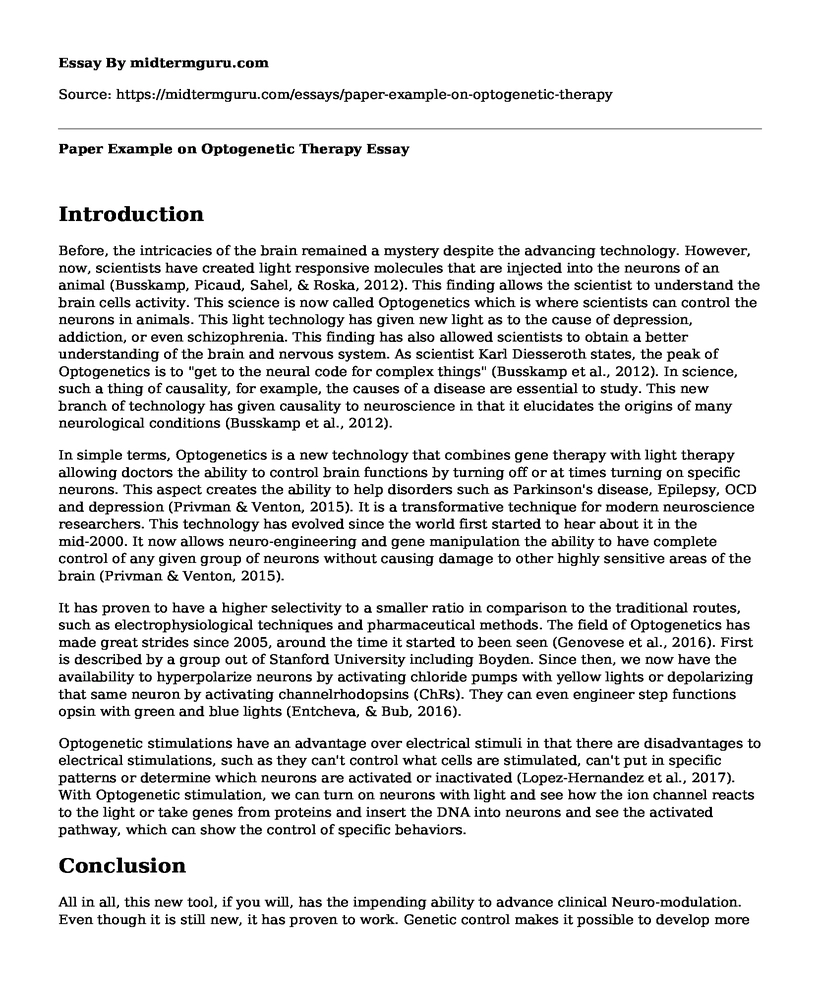Introduction
Before, the intricacies of the brain remained a mystery despite the advancing technology. However, now, scientists have created light responsive molecules that are injected into the neurons of an animal (Busskamp, Picaud, Sahel, & Roska, 2012). This finding allows the scientist to understand the brain cells activity. This science is now called Optogenetics which is where scientists can control the neurons in animals. This light technology has given new light as to the cause of depression, addiction, or even schizophrenia. This finding has also allowed scientists to obtain a better understanding of the brain and nervous system. As scientist Karl Diesseroth states, the peak of Optogenetics is to "get to the neural code for complex things" (Busskamp et al., 2012). In science, such a thing of causality, for example, the causes of a disease are essential to study. This new branch of technology has given causality to neuroscience in that it elucidates the origins of many neurological conditions (Busskamp et al., 2012).
In simple terms, Optogenetics is a new technology that combines gene therapy with light therapy allowing doctors the ability to control brain functions by turning off or at times turning on specific neurons. This aspect creates the ability to help disorders such as Parkinson's disease, Epilepsy, OCD and depression (Privman & Venton, 2015). It is a transformative technique for modern neuroscience researchers. This technology has evolved since the world first started to hear about it in the mid-2000. It now allows neuro-engineering and gene manipulation the ability to have complete control of any given group of neurons without causing damage to other highly sensitive areas of the brain (Privman & Venton, 2015).
It has proven to have a higher selectivity to a smaller ratio in comparison to the traditional routes, such as electrophysiological techniques and pharmaceutical methods. The field of Optogenetics has made great strides since 2005, around the time it started to been seen (Genovese et al., 2016). First is described by a group out of Stanford University including Boyden. Since then, we now have the availability to hyperpolarize neurons by activating chloride pumps with yellow lights or depolarizing that same neuron by activating channelrhodopsins (ChRs). They can even engineer step functions opsin with green and blue lights (Entcheva, & Bub, 2016).
Optogenetic stimulations have an advantage over electrical stimuli in that there are disadvantages to electrical stimulations, such as they can't control what cells are stimulated, can't put in specific patterns or determine which neurons are activated or inactivated (Lopez-Hernandez et al., 2017). With Optogenetic stimulation, we can turn on neurons with light and see how the ion channel reacts to the light or take genes from proteins and insert the DNA into neurons and see the activated pathway, which can show the control of specific behaviors.
Conclusion
All in all, this new tool, if you will, has the impending ability to advance clinical Neuro-modulation. Even though it is still new, it has proven to work. Genetic control makes it possible to develop more precise therapies by restricting the motivated or inhibited neurons to the disease-relevant group (Melchior et al., 2015). Additionally, the capability to simultaneously record electrical activity during optical stimulation without electrical pulse makes it possible to engage in responsive Neuro-modulation by vigorously correcting the encouragement or reserve force based on responses from brain activity. Optogenetics opens new opportunities for more precise marking out of disease mechanisms and hopefully a better treatment Forms.
References
Busskamp, V., Picaud, S., Sahel, J. A., & Roska, B. (January 01, 2012). Optogenetic therapy for retinitis pigmentosa. Gene Therapy, 19, 2, 169-75.
Entcheva, E., & Bub, G. (January 01, 2016). All-optical control of cardiac excitation: combined high-resolution optogenetic actuation and optical mapping. Journal of Physiology, 594, 9, 2503-2510.
Genovese, F., Thews, M., Mohrlen, F., & Frings, S. (January 01, 2016). Properties of an optogenetic model for olfactory stimulation. Journal of Physiology, 594, 13, 3501-3516.
Lopez-Hernandez, G. Y., Ananth, M., Jiang, L., Ballinger, E. C., Talmage, D. A., & Role, L. W. (January 01, 2017). Electrophysiological properties of basal forebrain cholinergic neurons identified by genetic and optogenetic tagging. Journal of Neurochemistry, 142, 2, 103-110.
Melchior, J. R., Ferris, M. J., Stuber, G. D., Riddle, D. R., & Jones, S. R. (January 01, 2015). Optogenetic versus electrical stimulation of dopamine terminals in the nucleus accumbens reveals local modulation of presynaptic release. Journal of Neurochemistry, 134, 5, 833-844.
Privman, E., & Venton, B. J. (January 01, 2015). Comparison of dopamine kinetics in the larval Drosophila ventral nerve cord and protocerebrum with improved optogenetic stimulation. Journal of Neurochemistry, 135, 4, 695-704.
Cite this page
Paper Example on Optogenetic Therapy. (2022, Aug 18). Retrieved from https://midtermguru.com/essays/paper-example-on-optogenetic-therapy
If you are the original author of this essay and no longer wish to have it published on the midtermguru.com website, please click below to request its removal:
- Public Health Paper Sample: HIV Phases
- Euthanasia and Suffering Essay Example
- Essay Sample on Nutrition
- Personal Worldview and Nursing Theory - Essay Sample
- Essay Sample on Bio Ethics: Moral Permissibility of Abortion
- Essay Sample on Pneumonia
- Understanding Autism Spectrum Disorder (ASD): Challenges & Contributing Factors - Research Paper







